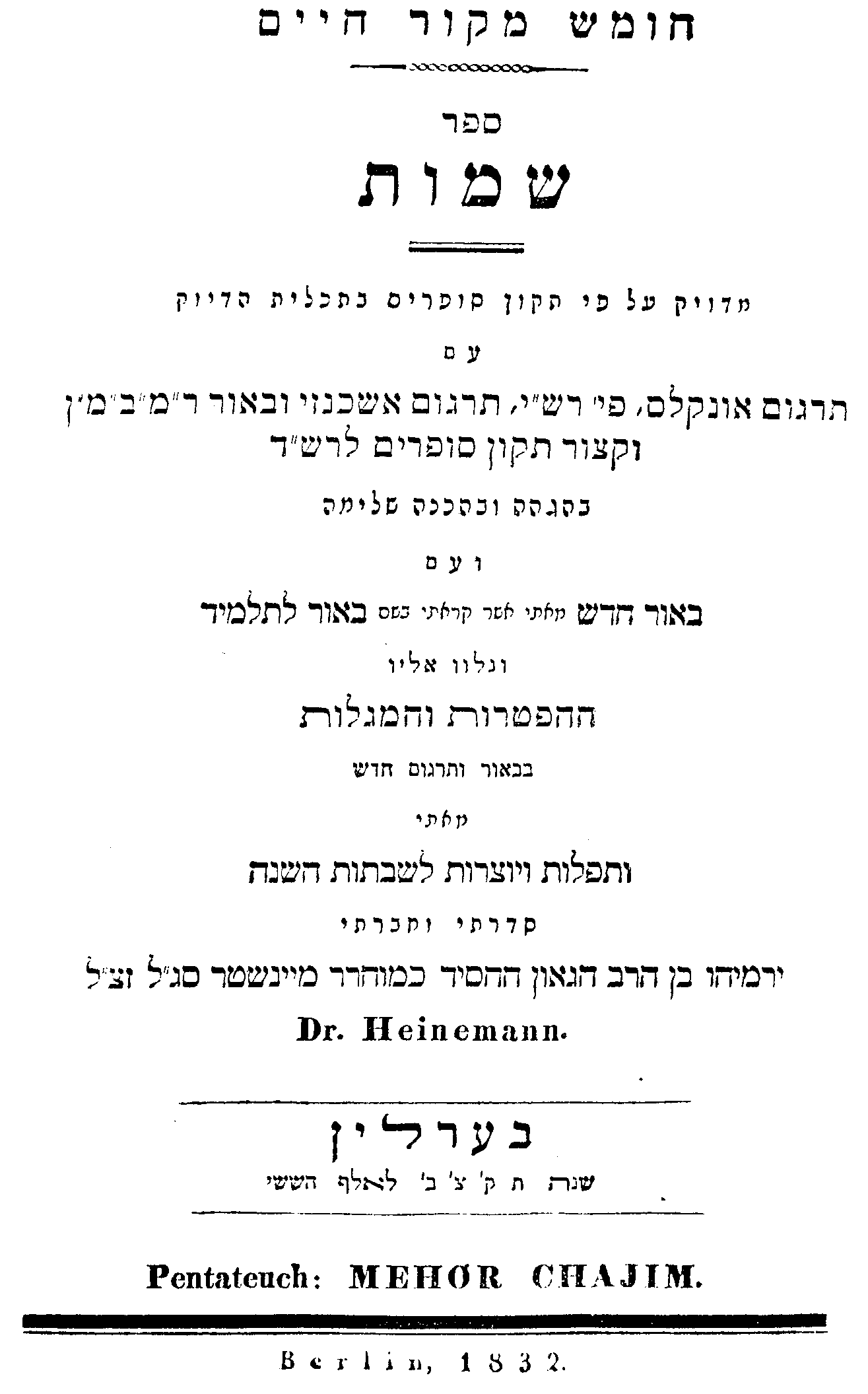All this discussion about the "real" R' Akiva Eger on Hirhurim and OnTheMainLine triggered something for me.
I have the volume in question.
I read and photographed the haskama of R' Akiva Eger to the 1832 Berlin chumash with Mendelssohn's commentary, and it does and doesn't quite mean as much as I think we'd like it to mean. Which is to say, I don't know if Dr. Heinemann sent the full chumash pages to R' Akiva Ginz (Eger). The haskama seems unclear - it says "targumim", which it seems would imply the German as well as the Aramaic, but the haskama seems to be primarily (only?) on Dr. Heinemann's commentary, "Biur LeTalmid".
I have the volume in question.
I read and photographed the haskama of R' Akiva Eger to the 1832 Berlin chumash with Mendelssohn's commentary, and it does and doesn't quite mean as much as I think we'd like it to mean. Which is to say, I don't know if Dr. Heinemann sent the full chumash pages to R' Akiva Ginz (Eger). The haskama seems unclear - it says "targumim", which it seems would imply the German as well as the Aramaic, but the haskama seems to be primarily (only?) on Dr. Heinemann's commentary, "Biur LeTalmid".
Here's the title page:

note, RMBMN is R' Moshe ben Menachem Mendel (Mendelssohn).
and the haskamah:

Translation (approximate):
heading: I thought this sufficiently important to give it its own page in this volume.
Peace and blessings to you, perfect in Torah, wise writer my teacher rav Jeremiah Heinemann,
I recently received your nice letter, you should have a palanquin for publishing beautifully the Chumashim, with the translations and Rashi and Tikun Sofrim by R' S.D., and the extra commentary Biur Letalmid, and when you sent me several leaves to show their beauty, and for asking me for a haskamah, what can I do if it is impossible for me to fulfill your request since I never write haskamot on any book, and furthermore, since there is no reason to do so here, if the book is really so good won't everyone see that it is so, and if you're afraid that others will encroach on your borders and reprint the book before your printer sells out, surely one should not suspect any fellow Jew of such "theft of holy things". May God allow you to bring your work into reality. And here I am, one who has subscribed to buy a copy of your book at full price.
I remain, Akiva ben Moshe Ginz Z"L.
This is even more a non-haskamah than the famous one by the Noda beYehuda to R' Naftali Herz Wessely's commentary Yein Levanon on Pirke Avot. That one basically says, "his last book was good, he's a good guy, if he sticks to kosher ideas this book should be good too."
Right-click on the picture, then "View Image" from the menu, to see the high-res version.
3 comments:
Any chance that you can make a high resolution copy of the haskama?
I would love to be able to print it out and show it to some people.
Thanks
It is a high-resolution image. Right-click on it, pick "View image" from the menu, and when the magnifying glass appears click on that. Then save it.
The width="80%" attribute on the IMG tag scales it down for the width of your blog window, but the image itself is pretty high-res. It came from a 5MP camera, after all. A little post-processing with Paint-Shop Pro to turn it into black-and-white, and eliminate the page curvature and camera-angle, and there you have it.
I wish I could find things like this on my book shelf!
In any event, I agree that the actual content of the haskamah doesn't make R Akiva Eiger out to be an Aufklärer, but that wasn't my point in the first place! What I was getting at was that today even the faint scent of Mendelssohn is very much verboten in Chareidi circles. This is in stark contrast to the historical R Akiva Eiger who would write a haskama for and purchase an edition of the Chumash with Mendelssohn's German translation (and who would also quote this translation).
This is largely because the Chareidi heritage has been shaped by one particular way that the 19th century Ultra-Orthodox went but not the other. I don't mean to say that the other way was necessarily more open or less "frum," only that it's Da'as Torah, so to speak, wasn't identical. As I said, the attack on Mendelssohn in the 18th century was primarily about German. In the 19th century that was no longer the issue. Then the issue became about him personally and his followers. At that point there were those who recognized that the Bi'ur was a very good Chumash with a very good peshat commentary, and there were those who refused to separate it from Mendelssohn the person and the Haskalah.
Post a Comment